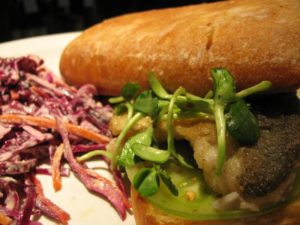- October 15th, 2010
- 3 Comments
I’d thought I’d apply my curious eyes to our menu at Southport Grocery & Cafe. As my first go I took a look at the walleye pike sandwich. The menu description reads:
sunflower dusted walleye pike topped with green tomato-sunflower sprout salad & basil aioli on a tuscan loaf with coleslaw
What’s the background on these ingredients? On sunflower dusted walleye, or Tuscan loaf, or basil aioli? How do you even pronounce ‘aioli’ anyways? And why not say this sandwich is just a slab of fish slapped between two pieces of bread? Because it turns out that the walleye pike sandwich is much more than that. I discovered interesting things about a few key ingredients:

Walleye pike
The namesake of this sandwich is a fish native to the Great Lakes. It has a white meat and slightly sweet flavor, making it popular among a variety of palates. “I’m not usually a fish person,” says Drew, one of Southport Grocery’s servers, “but the walleye has a nice, light taste. It’s not too fishy or heavy.”
The majority of walleye pike are caught from Lake Erie. They can grow upwards of two and a half feet and weigh twenty pounds, and are known for some unusual characteristics — walleye pike have thousands of taste buds on their lips, and also have a keen sense of sight. The name walleye itself derives from the light that reflects from their eyes. Many fishermen look for the “eyeshine” when seeking walleye.
Your own eyes will shine when you taste the walleye pike at Southport Grocery, seriously. It’s coated in crushed sunflower seeds and then pan-fried, resulting in a mild, nutty taste – an excellent accompaniment to the fresh flavors of green tomatoes and sunflower sprouts.

Aioli
Pronounced ahy-OH-lee, it is a French sauce that combines lemon, eggs, garlic and olive oil into a creamy mixture resembling mayonnaise. It’s usually paired with vegetables, meat and fish, adding a garlicky lemon zest to otherwise plain foods. Aioli originated in Provence, the southeastern region of France adjacent to Italy and the Mediterranean Sea. It’s sometimes referred to as the “butter of Province” because real butter isn’t a common ingredient in the regional cuisine.
One thing I found particularly fascinating about aioli is that in the professional culinary world, aioli is classified as an emulsion – a uniform mixture of two otherwise unmixable liquids. Hence the beauty of aioli. It takes a patient and steady hand to create. Using quality eggs, incorporating the olive oil very slowly, and constantly stirring are essential to the magic of emulsion. Otherwise the eggs could curdle and remain separated.
Southport Grocery’s homemade aioli has a bonus ingredient – fresh basil – giving the sauce a tangy pesto taste alongside a burst of lemon. “Oh man, it’s so good! I love the aioli. It has just enough lemony kick to complement the fish,” says Lance, a member of the Southport Grocery team.

Tuscan loaf
Not far from the land of aioli is Tuscany, a region in central Italy famous for its rich cultural heritage. It’s also widely regarded as the birthplace of the Italian Renaissance and was once home to Leonardo da Vinci, Michelangelo, Botticelli, Dante, Galileo Galilei and many other influential figures. Tuscany is also well-known for its culinary traditions, particularly in winemaking (Chianti, anyone?), so it’s no surprise that the region boasts its own bread as well. What makes Tuscan bread Tuscan, you ask? The key is in the salt – or lack thereof. Tuscan bread is made with little to no salt, yielding a loaf that is chewy without being tough, with a wonderful yeast flavor that doesn’t overpower other ingredients.
There are a number of theories as to why Tuscan bread contains no salt. One I came across dates the practice back to the 12th century, when the Tuscan city of Pisa held tight control over maritime trade. Pisa, being located on the coast of the Mediterranean Sea, sought to gain authority over other Tuscan cities inland. Supposedly the Pisans decided to raise the price of the salt that they had been importing and selling to these inland cities, including Florence, the modern-day capital of Tuscany. Angered by the increased cost, Florentines objected by baking their bread without salt – a tradition that continues today.

Regardless of theory, be sure to pay special attention to the lightly toasted bread when you order this sandwich. You’ll immediately notice that it’s a perfect match for the flavors of the basil aioli and the sunflower dusted walleye.
After discovering all of these interesting things, I have a new-found appreciation for the walleye pike sandwich. It’s fun to close my eyes and imagine that in one bite I’m simultaneously transported to the cool waters of Lake Erie, to the Mediterranean climate of Provence, France, to 12th century Italy, to patches of sunflowers and vines of green tomatoes…but then I open my eyes and I’m still right here, cozy in a corner table at Southport Grocery.
The Walleye Sandwich featured on ABC7’s The Hungry Hound
